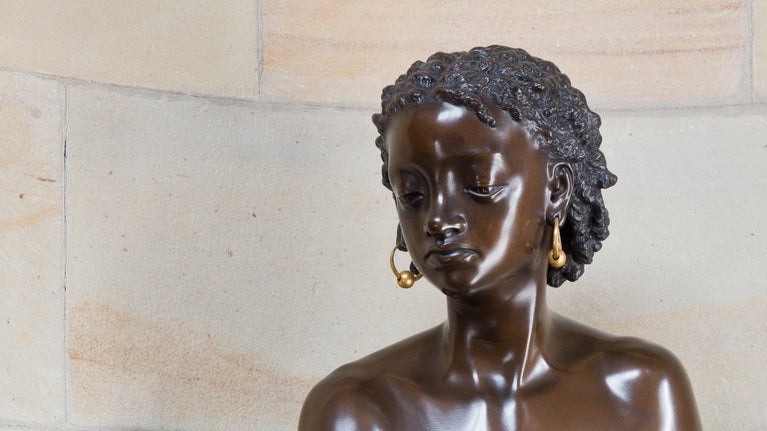A Daughter of Eve
- Published:
- 28 February 2023

A Daughter of Eve or The American Slave is a nearly life-sized bronze nude of a manacled African woman, waiting to be transported to North America.
British sculptor, John Bell (1811-1895) created this work as a protest against slave ownership in North America. Its title expresses his personal, Christian view that, as descendants of Eve, all women are equal regardless of their race. The artist himself expressed the hope that art might 'aid in directing a sustained attention to the greatest injustice in the world'. However, the depiction of the female figure as partially nude and chained objectifies the figure's body in a way that can feel deeply uncomfortable today.
Bell has attempted to show the humanity, beauty, and vulnerability of the woman in the scene. However, the depiction of the African woman itself is racially stereotyping, and sexualised. This is partially due to Bell's attempt to mimic the classical nudes of Ancient Greece, and partially to do with Victorian attitudes towards race, as well as towards women, which are opposed to our modern values. The niche opposite contains a classical-style marble nude of a crouching white woman (NT1231012). The positioning of the two statues creates a potentially unsettling comparison.
Britain dominated the 18th century transatlantic slave trade. Huge numbers of enslaved Africans died on the journey across the Atlantic. Britain passed the Slavery Abolition Act in 1833, but still benefitted from the goods produced by enslaved people in North America and parts of the Caribbean.
By 1860, the American South was producing 5 million 181kg bales of cotton per year, compared to an annual output of 2.3million kg in total at the end of the 18th Century. Cheap cotton produced by enslaved people was exported to the mills of Lancashire and clothed the British working classes[1].
A plaster version of the sculpture was exhibited at the 1853 Royal Academy Exhibition. This full-scale bronze version is believed to have been commissioned by Richard Seymour Conway, 4th Marquess of Hertford (1800-1870), and founder of the Wallace Collection. Its inspiration came from the phenomenal success of another statue the Greek Slave by Hiram Powers (1805-1873), which has an almost identical pose, which was shown at the Great Exhibition in 1851, and from the wave of public revulsion against slavery created by the publication of the novel Uncle Tom's Cabin in 1852 by Harriet Beecher Stowe (1811-1896).
After William Armstrong (1810-1900) purchased the statue, he displayed it prominently in a custom-built niche on the main stairs of his house at Cragside. We do not know why the Armstrongs chose to add the statue to their collection and whether or not it represents their personal support for Abolition. The Armstrongs were significant contemporary art collectors. Armstrong might have bought the statue around 1870, following the death of its previous owner, Seymour Conway, or in may be a version acquired directly from Elkington's after Armstrong visited their showrooms in 1865. Queen Victoria (1819-1901) also owned a copy of the statue, which was displayed in the gardens of Osborne House on the Isle of Wight. The Armstrongs, who regularly copied the Royal family's tastes, may have bought the statue for this reason.
Armstrong’s attitude towards the enslavement of people is now impossible to understand completely. His father was a close associate of Abolitionist James Losh (1763-1833), and his social circles in Newcastle included radical thinkers and writers. However, Armstrong is only known to have recorded his views directly once, as part of his lecture series on the 1872 visit to Egypt. In that series, he noted that enslaved people were ‘…much better off in Egyptian bondage, than under the rule of their own savage chiefs…as a matter of fact they are content with their lot, and do not run away.’ [2]
Cragside’s collection includes three significant representations of enslaved people. In addition to The Daughter of Eve, the Armstrong’s owned an ornamental marble column that is inlaid with a Wedgewood Abolitionist medallion (NT 1230999). The medallion design was created by potter Josiah Wedgwood (1730-1759) for the Society for Effecting the Abolition of the Slave Trade. Both of these objects can be understood as Abolitionist statements, but they represent enslaved people in a way that has been criticised for emphasising humility or gratitude rather than resistance. The third item is a decorative cigar casket (NT 1228296, not currently on display). This glazed box is supported by four bronzes of subjugated Black men representing four regions (Virginia, Havana, Maryland, and Brazil) where slavery was used to produce tobacco, as well as sugar, cotton, and cocoa. This casket was acquired by Armstrong some time before 1881, when it is shown prominently displayed in Cragside’s Library in an issue of magazine The Graphic.
We know little else about this object, which demands further research to explore its origin and complexities. The meaning of any of these objects in the context of the Armstrongs’ collection is open to analysis and discussion. We are a still thinking about how they could be displayed, and their stories shared with visitors to Cragside. Please send us your thoughts via cragside@nationaltrust.org.uk.
A Daughter of Eve has been on loan
A Daughter of Eve has recently been part of two major exhibitions. Colour Revolution: Victorian Art, Fashion & Design at the Ashmolean and Entangled Pasts 1768-now: Art, Colonialism and Change at the Royal Academy.


